This collection of stunning and famous antique insect art is by Joris Hoefnagel, and it’s free to download and print.
Joris Hoefnagel (1542-1601) was a famous 16th-century Flemish artist and merchant. He was mainly well known for his illustrations of natural history subjects, topographical views, drawings and mythological works.
He was self-taught as an artist. Hoefnagel used watercolours, gouache, and gold to produce some of the most amazing miniature paintings of animals.
Another famous collection of Hoefnagel was the natural history illuminations he painted in the renowned Renaissance book “Mira Calligraphiae Monumenta.“
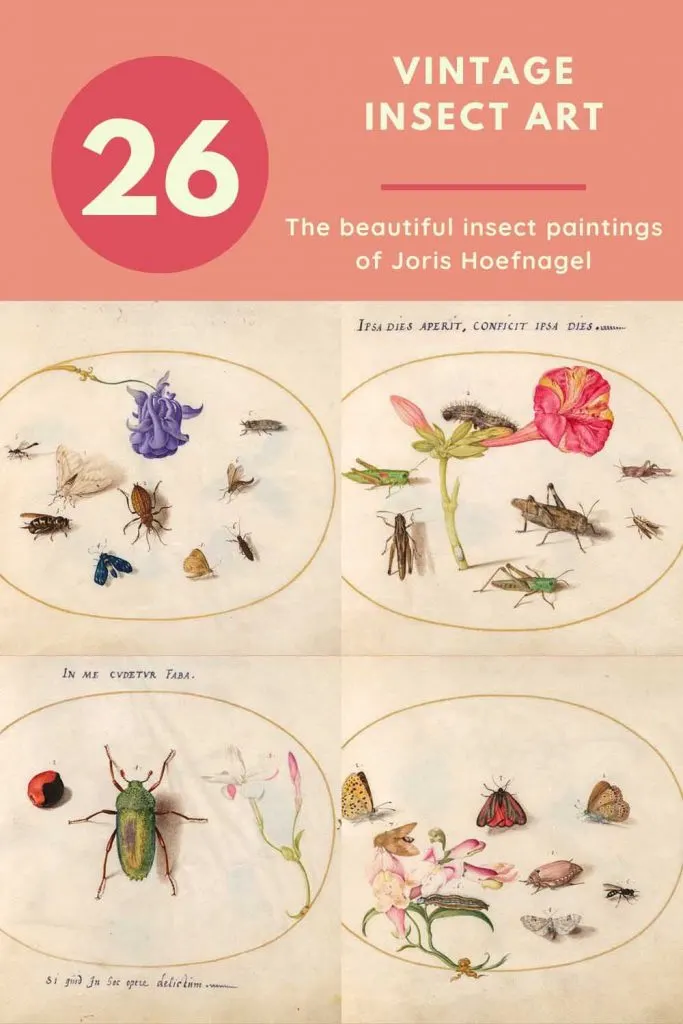
Insect Art Prints from the Four Elements
His most famous work is the Four Elements which comprises four volumes of miniature paintings of the natural world reflecting the four elements of fire, earth, air and sea.
The drawings of the animals were divided according to the elements.
The insect art prints curated here are from the first volume Animalia rationalia et insecta (ignis); Insects and fire.
The other volumes were:
- Animalia quadrupedia et reptilia (terra) ; Footed animals and reptiles, (earth).
- Animalia aquatilia et conchiliata (aqua); Aquatic animals and creatures of the sea (water).
- Animalia volatilia et amphibia (aier); Birds and amphibians, animals of the air.
Hoefnagel did not paint all the works in the book but rather copied from other artists’ works. These included a series of drawings by the Antwerp animal painter Hans Verhagen den Stommen and woodcuts from Konrad Gessner’s Historia Animalium.
Hoefnagels’ excellent book on the natural world was critical to 16th-century science. It provided a compendium of the entire known animal world at that time.
These insect illustrations also influenced the famous Flemish and Dutch still-life art. Especially the still-life flower paintings that often featured insects too.
The downloaded insect paintings will be higher resolution than the images below.
To download the antique Insect Art prints, click on the highlighted title link. A larger image of the insect drawings will open in a new window in your browser. You can then print this image or save it to your hard drive.
1. Insect Art Plate 5 Stag Beetle
The name stag beetle is derived from the large and distinctive mandibles found on the males of most species, which resemble stags’ antlers.

2. Insect Art Plate 9 Yellow Butterflies
Hoefnagel’s insect illustration of four yellow butterflies.
Butterflies are insects with skeletons on the outside of their bodies, called exoskeletons. These exoskeletons protect the insect and keep water inside its body so it doesn’t dry out.
Like all insects, butterflies have three body parts: the head, the thorax with wings and six legs, and the abdomen.
There are about 18,500 named species of butterflies. They can be found on all continents except Antarctica, where it is too cold for them to survive.
There is a collection of vintage butterfly images on Picture Box Blue.
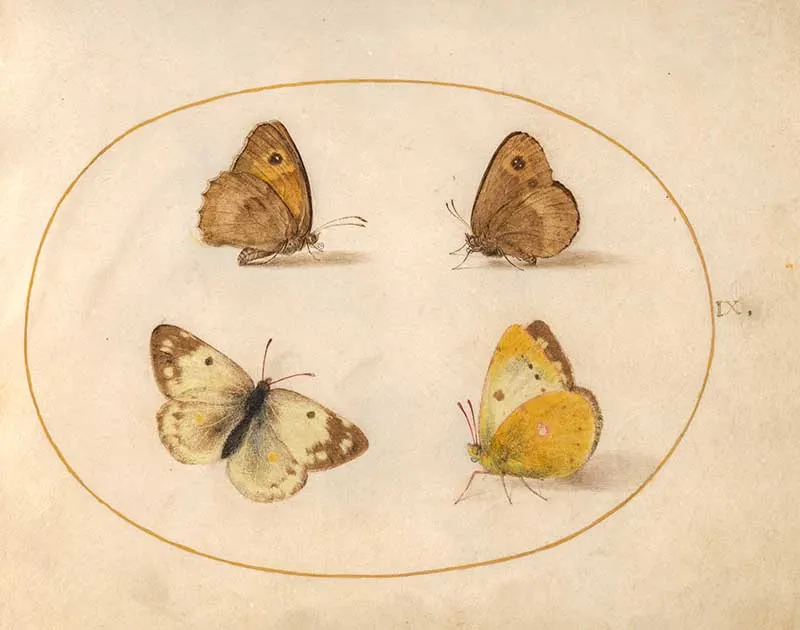
3. Plate 13 Blue Butterflies
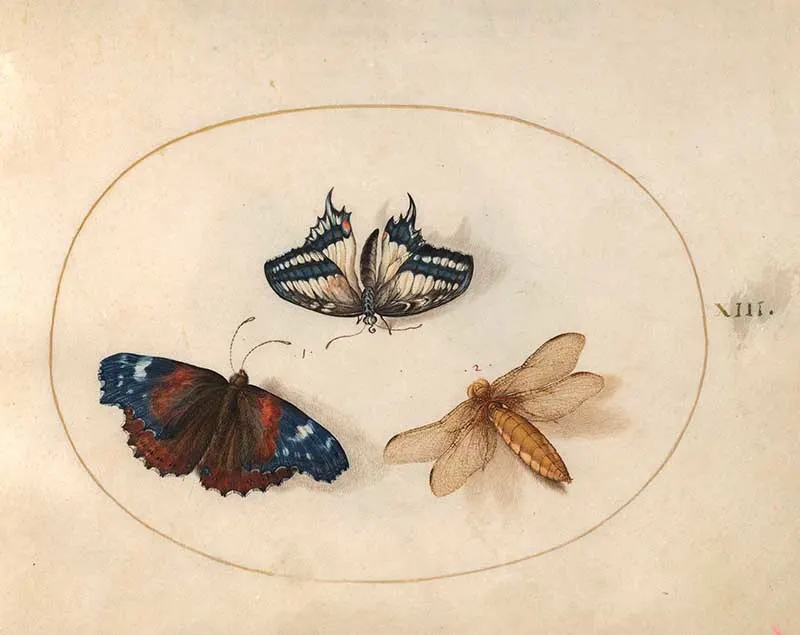
4. Plate 17 Various Insects Including Blue Dragonfly
Dragonflies are a common emblem on cultural artefacts such as pottery, rock paintings, statues, and Art Nouveau jewellery. They are used in traditional medicine in Japan and China and caught for food in Indonesia.
Dragonflies are symbols of courage, strength, and happiness in Japan but are seen as sinister in European folklore. There are many more dragonfly drawings to be found in this collection here.
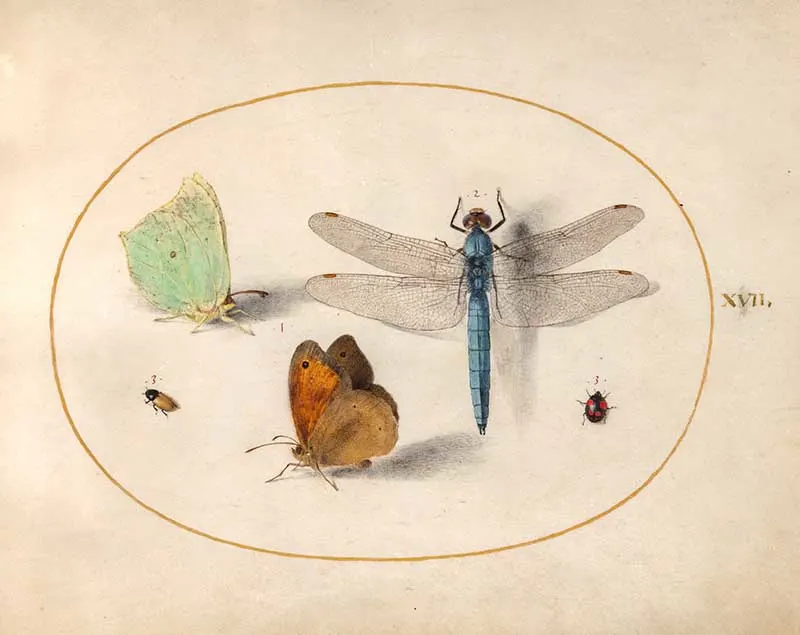
5. Plate 19 Assorted Flying Insects

6. Plate 22 Pink Flowers and Moths

7. Plate 25 Two Large Moths

8. Plate 27 Large Moth And Other Insect Art
Moths, like butterflies, belong to the scientific order Lepidoptera. There are thought to be approximately 160,000 species of moth, most of which are nocturnal.

9. Plate 33 Lilac Flower and Insects
The lilac flower looks a bit like a bluebell (but I have now been informed it’s a columbine), which grows wild on the forest floor and is popular with insects.

10. Plate 34 Assorted Insects Including Woodlouse
I know these insect drawings were from work by Joris Hoefnagel titled Animalia rationale et Insecta (ignis); Insects and fire. However, not all the creatures he illustrated were true insects.
For example, woodlice may look like insects, but they’re crustaceans and are related to crabs and lobsters.

11. Plate 35 Giant Spider
The writing on this insect illustration appears to be some religious Latin quote and has nothing to do with identifying the spiders in the picture as I first thought.
(However, my Latin is practically non-existent so I can’t be sure).

12. Plate 39 Insect Art Spiders
This book of insect art and prints includes spiders. Although both spiders and insects are invertebrates, spiders are not insects.
All Insects have three body parts: the head, the thorax with wings and six legs, and the abdomen. Spiders are Arachnids with two body parts: the cephalothorax (head + thorax) with eight legs, and the abdomen.

13. Plate 42 Green Beetle
Beetles are distinguished from other insects in that their front pair of wings are hardened into wing cases, elytra.
Beetles are from the largest family of insects, Coleoptera, with about 400,000 species. This is about 40% of all known insects and 25% of all known animal life forms. And even more new species are discovered frequently.
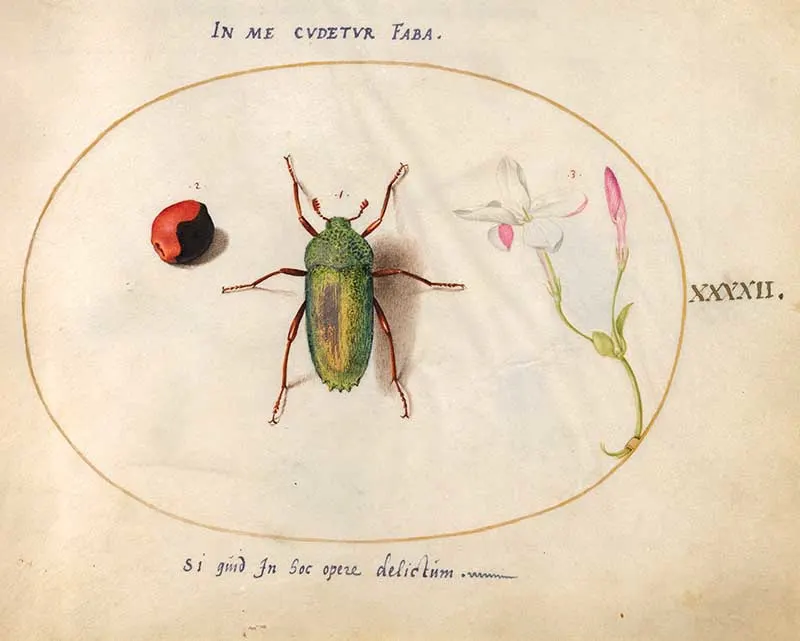
14. Plate 43 Insect Art Many Beetles

15. Plate 44 Unusual Insects Including Mantis
Mantis all have forelegs that are greatly enlarged and adapted for catching and gripping prey; their upright posture, while remaining stationary with forearms folded, has led to the common name praying mantis.

16. Plate 45 Locusts
These insects look like locusts to me, and they are a type of grasshopper.
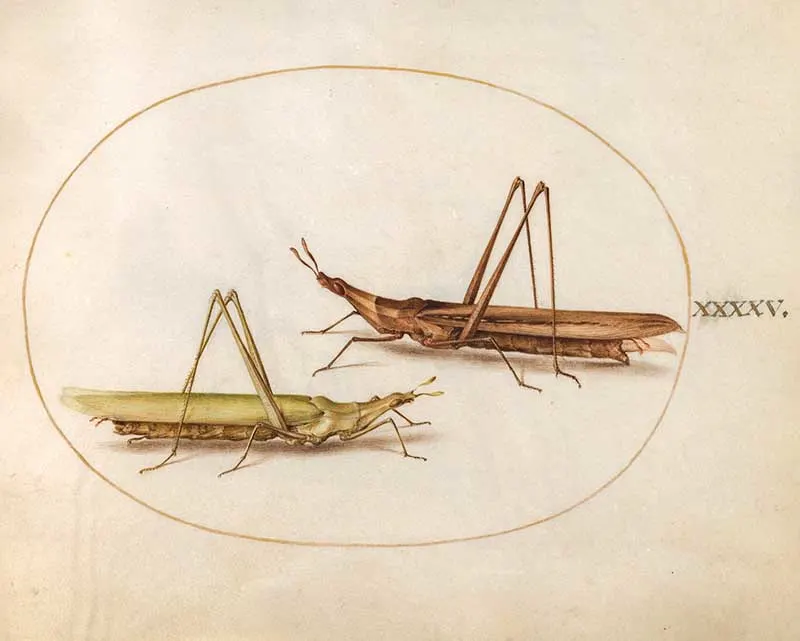
17. Plate 46 Insect Illustration Grasshoppers
Grasshoppers have had a long relationship with humans. Swarms of locusts can have devastating effects and cause famine; even in smaller numbers, the insects can be serious pests.
They are used as food in countries such as Mexico and Indonesia and are commercially farmed for food and protein supplements.
Grasshoppers are featured in art, symbolism, and literature. They were a feature in some of the Dutch Masters’ still lifes inspired by these insect paintings of Joris Hoefnagel.

18. Plate 47 Various Insects Including Flies

19. Plate 50 Grasshoppers and Flower

20. Plate 51 Butterfly and Caterpillar on Flower

21. Insect Drawing Plate 53 Large Dragonfly
The detail of this large dragonfly illustration is incredible.
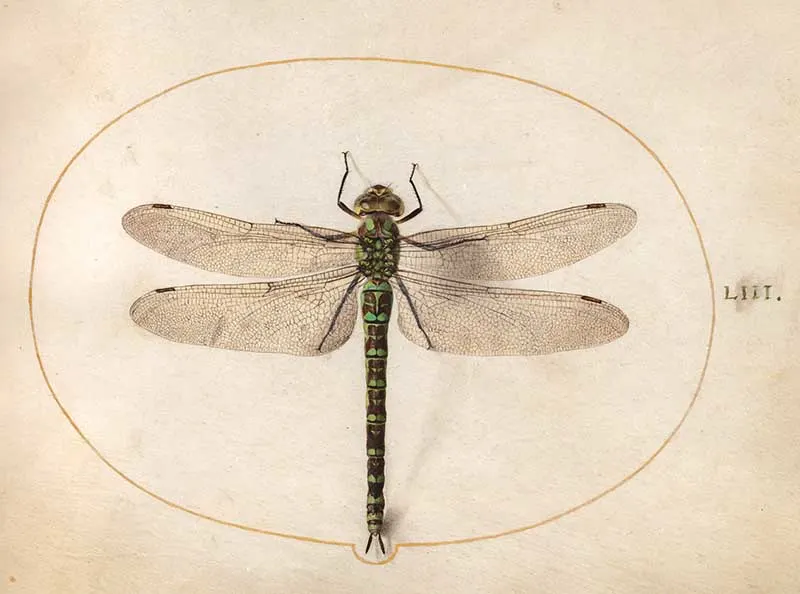
22. Hoefnagel Plate 57 Mosquito
Mosquitoes are the deadliest animals in the world. They are believed to kill over a million people every year through their transmission of deadly diseases.

23. Plate 63 Wasps and Flower

24. Plate 69 Bees and Wasps
Wasps and bees are both members of the Hymenoptera order of insects. However, their bodies are different; bees are hairy, while wasps usually have smooth and shiny skin.
Wasps are narrow-waisted, have four wings and may be brightly coloured, with black and yellow patterns; unlike bees, which can sting only once, wasps can sting multiple times.

25. Plate 78 Ladybird and Other Insects
Ladybirds (ladybugs), after butterflies, must be one of the most popular insects.
They are not just because they are pretty but because the bugs are considered a gardener’s friend. Most ladybird species prey on herbivorous agricultural pests such as aphids.

26. Insect Art Plate 79 Assorted Small Insects

I hope you enjoyed this carefully curated collection of amazingly detailed antique insect illustrations as much as I did. You can find more vintage insect prints on Pillarboxblue. These include art from Fabre’s Book of Insects, Maria Sibylla Merian prints’ stunning insects and plants, and Jan Brandes’s vintage nature illustrations.
More vibrant insect illustrations are the art nouveau instects of E. A. Seguy.
Other natural history collections you might also enjoy are the fabulous natural history posters of Adolphe Millot. Also, the collection of vintage animal prints, and all the various collections of vintage bird prints.
I used some of these vintage insect images with this nature Inspired decoupaged paper mache bowl.

There is a holly illustration with an insect here.
If you fancy, you can Buy Me A Coffee Here.

Tom Henshaw
Thursday 7th of July 2022
Claire, it's curious that in 16th and 17th century illustrations, engravings, and the flower pieces of the Dutch and Flemish masters (such as those by Ambrosius Bosschaert the Elder) the columbine is invariably depicted bell-like and hanging down. Put in an online search for columbine, and the photographs invariably depict them open - almost "rampant"(!)
One particular insect illustration by Hoefnagel was employed so many times by Bosschaert that it became a kind of signature. The illustration is of a bluebottle. The similarity is so marked that there can be little doubt that Bosschaert knew Hoefnagel's illustration.
claire
Monday 11th of July 2022
Thank you, Tom, I haven't studied the paintings that closely but that does sound very interesting. I'm sure the Dutch masters all know of Hoefnagel's work.
Tom Henshaw
Sunday 3rd of July 2022
Illustration 9. Plate 33 Lilac Flower and Insects.
The "Lilac Flower" is a columbine, not a bluebell.
claire
Monday 4th of July 2022
Thank you for the correction.
Abigail
Saturday 25th of September 2021
The pictures by Hofnagel are terrific, it's just a shame that pictures 17 and 24 cannot be enlarged. Thanks for that.
claire
Monday 27th of September 2021
Thank you, I'll try and fix it so that they can all be enlarged.
Teodora
Monday 25th of May 2020
Wow! Amazing skill to be able to paint/draw at this level. They are all exquisite. I particularly love the dragonfly.
claire
Monday 25th of May 2020
Yes they are amazing, the detail is so fine.
Shari Harniss
Thursday 21st of May 2020
Wow! I wonder what it would be like to draw and paint at this level. The details are just perfect. Very life like. Thank you once again!
claire
Saturday 23rd of May 2020
Thank you, yes the paintings are amazingly detailed.